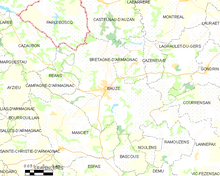Eauze | |
|---|---|
 The town hall in Eauze | |
| Coordinates: 43°51′44″N0°06′07″E / 43.8623°N 00.102°E | |
| Country | France |
| Region | Occitania |
| Department | Gers |
| Arrondissement | Condom |
| Canton | Armagnac-Ténarèze |
| Intercommunality | Grand Armagnac |
| Government | |
| • Mayor (2020–2026) | Michel Gabas [1] |
Area 1 | 72.00 km2 (27.80 sq mi) |
| Population (2022) [2] | 4,060 |
| • Density | 56/km2 (150/sq mi) |
| Time zone | UTC+01:00 (CET) |
| • Summer (DST) | UTC+02:00 (CEST) |
| INSEE/Postal code | 32119 /32800 |
| Elevation | 106–193 m (348–633 ft) (avg. 126 m or 413 ft) |
| 1 French Land Register data, which excludes lakes, ponds, glaciers > 1 km2 (0.386 sq mi or 247 acres) and river estuaries. | |
Eauze (French pronunciation: [eoz] ; Gascon: Eusa) is a commune in the Gers department in southwestern France.





